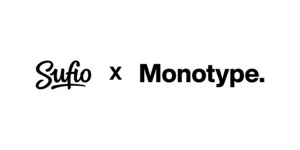- Monotype's neuroscience research shows that different font styles evoke varied emotional responses, depending on the country
- Research offers fresh insights on differing type and emotional response, split by eight countries — Australia, France, Germany, Japan, Portugal, Spain, the UK, and the US
- The findings, shared in a new report, "Typography Matters: How to Leverage Neuroscience to Build a Memorable Brand," provide essential reading for brands, creatives, and for organizations developing public information campaigns
WOBURN, Mass., Dec. 13, 2023 /PRNewswire/ -- Monotype, a global leader in type and technology, has released new research that reveals that the emotional response to different fonts varies significantly from one country to another. This ongoing, first-of-its-kind study was conducted in collaboration with applied neuroscience company, Neurons. The findings reveal the emotional impact of fonts and the cultural nuances in responses across eight different countries: Australia, France, Germany, Japan, Portugal, Spain, the UK, and the US.
In the testing of three distinct typefaces, researchers discovered that while the choice of typeface plays a crucial role in eliciting emotional responses, the preference for, and impact of, fonts vary significantly depending on cultural contexts and geographical locations.
"The differences in the UK and France results show us how much two geographically close cultures can have varied reactions to typography and language," remarked Damien Collot, Creative Type Director at Monotype in France. "For brands creating advertising campaigns and organizations running public information campaigns, having a research-based understanding of how responses to font choice vary across different regions and languages is a key to potentially unlocking deeper, more meaningful engagement with audiences."
Where Art Meets Science
Since 2021, Monotype has been researching the hidden power of typefaces to shape our emotional responses, and the ways in which they convey emotion, shape perceptions, and influence brand identities. The latest findings offer new guidance for marketers on how to adapt brand strategies and creative executions for different regions, taking cultural and linguistic differences into account.
Key findings of the report across all regions include:
- Dynamic Serifs: Serif typefaces, like Cotford, convey honesty and quality. Cultural associations with serifs make them a compelling choice for brands aiming to evoke these emotions.
- Humanist Sans Serifs: Fonts like FS Jack can suggest innovation and distinction. FS Jack's design, with roots in calligraphy, often elicits emotional responses related to prominence and innovation.
- Geometric Sans Serifs: Typefaces like Gilroy Bold are associated with honesty and clarity. Gilroy performs well in conveying these attributes, especially for longer messaging.
- Type size, color, and spacing all influence how type is seen and felt.
Cultural Considerations
The report reveals that type choices and emotional responses vary across different languages and cultures. While designers and creatives often have a sixth sense for the emotional response different fonts can convey, this sense is frequently bound by their own cultural and linguistic experiences. This report emphasizes the value of considering research into regional differences in responses to type when making font choices for international brand and marketing campaigns.
Key Findings from Various Countries:
- Preferences for typefaces and emotional associations varied substantially by language and language family. This offers valuable insights for brand marketers, creatives, and public bodies.
- Respondents in English-speaking countries Australia, the UK, and the US showed a preference for distinctive characteristics in typefaces.
- France, Portugal, and Spain, regions with a rich history of printing which saw the rapid spread of movable type in Europe, showed a significant preference for Cotford's soulful, classic serif style.
- While sans serif FS Jack Regular scored highest for conveying trust in all seven other countries surveyed, Cotford performed best for trust in Germany.
- Gothic, low-contrast, humanistic typefaces work extremely well to convey innovation in Japan.
- High contrast typefaces that preserve a traditional brushstroke feel were considered trustworthy in Japanese design.
Monotype's latest research on cultural font perception encourages brand and public information decision-makers to think beyond color and logos and to consider the emotional power of type as a crucial tool in building memorable, engaging, and impactful messages and campaigns.
"Everyone brings their own history and personal perceptions to a typeface," notes Phil Garnham, Executive Creative Director at Monotype. "But what's fascinating about our research is that it reveals those perceptions are, at least in part, influenced by where we live and the history of our culture and language. Our research is not exhaustive (to date, we've studied eight countries around the world) and as we continue to expand and diversify our research program with Neurons, we expect to uncover more insights on the complex, nuanced, and infinitely fascinating interplay between type and emotion."
All the data in the report was collected by Monotype and Neurons through a series of surveys and studies comprising 1,957 participants. In countries using Latin typefaces, three contrasting typefaces were tested including FS Jack, Gilroy, and Cotford. In Japan, tested fonts include DNP Shuei Mincho, Shorai Sans, and Tazugane Gothic. The survey encompassed three types of stimuli including single words, sentences using these words, and sentences incorporating a mock brand. Respondents evaluated these combinations, considering a range of emotional metrics, including sincerity, memorability, trustworthiness, and confidence.
To learn more about the profound influence of typography on brand success, access the full report, and explore case studies, visit Typography Matters.
About Monotype
Monotype creates brands that matter with type, technology, and expertise.
The company partners with leading foundries to deliver the broadest inventory of high-quality typefaces in the world. Further information is available at www.monotype.com.
Follow Monotype on X, Instagram and LinkedIn.
Monotype is a trademark of Monotype Imaging Inc. registered in the U.S. Patent and Trademark Office and may be registered in certain other jurisdictions. All other trademarks are the property of their respective owners.
©2022 Monotype Imaging Holdings Inc. All rights reserved.
Photo - https://mma.prnewswire.com/media/2299885/tmp_98e19a89_5c01_49b1_9a30_a252687d8206.jpg
Logo - https://mma.prnewswire.com/media/1741762/Monotype__Logo.jpg





Share this article